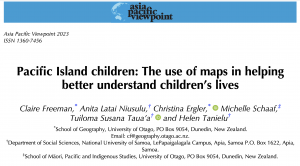It is great to see collaborative Pacific research by scholars across Otago’s schools and universities.The latest is a journal article in Asia Pacific Viewpoint featuring Te Tumu’s Dr Michelle Schaff, along with academic staff from the School of Geography and National University of Samoa on the use of maps in helping better understand Pacific children’s lives. Click here to view this open access article.
Abstract
Children’s voices have been little heard in the Pacific research. The United Nations Convention on the Rights of the Child 1989 asserts the child’s right to have a say on matters that affect them and for their views to be considered. There has been massive growth in technologically assisted participative research; however, we argue the value of hand drawn maps should not be underestimated in the rush to engage with more advanced techniques. We present data from 267 neighbourhood maps drawn by children in Fiji, Kiribati, Samoa and New Zealand. To better understand the social construction of knowledge in children’s everyday lives, we propose two models to conceptualise the complexity of their world, a social connection and a spatial connection model. These models reveal how Pacific Island children negotiate different levels of social connection from home, family, and community through to transnational kinship relations. People, specifically family, provide the geographic basis on which their spatial encounters are overlaid. Irrespective of country or rural/urban/atoll setting, it is social space that is the strongest connector for children as displayed in their maps. Application of our models can be used to reveal how knowledge is socially constructed in Pacific children’s everyday lives.


